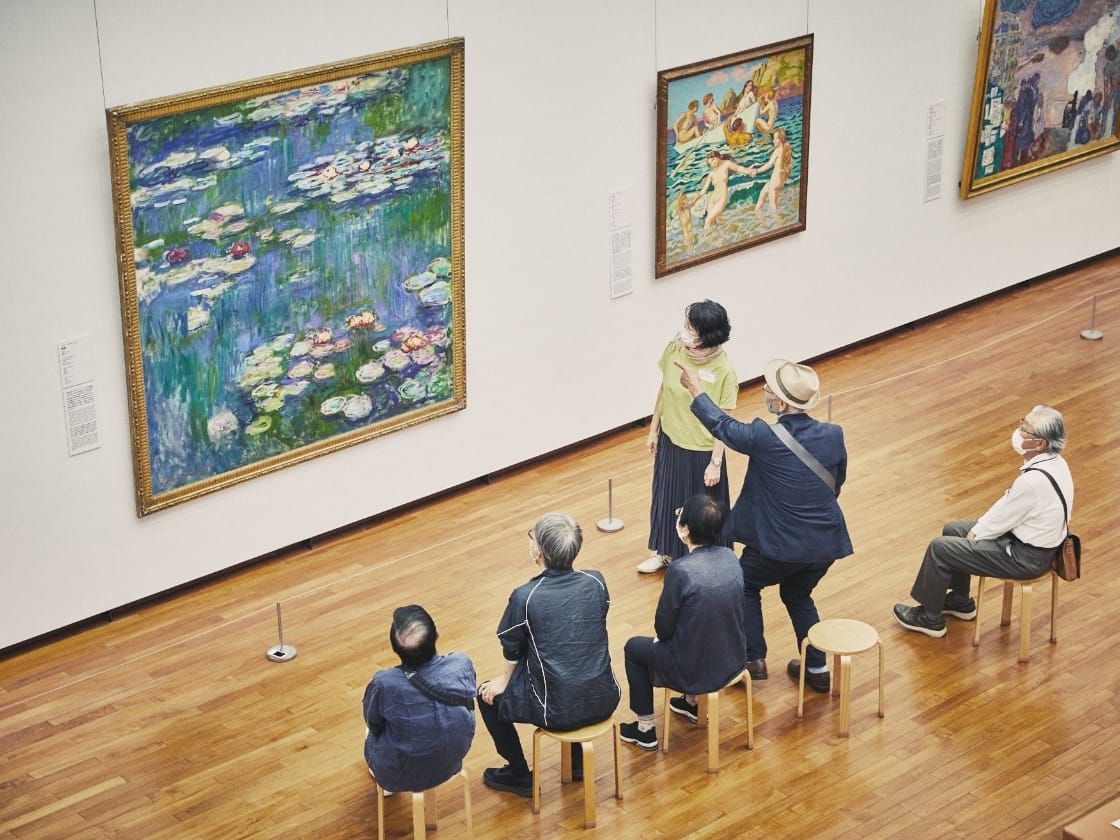My Favorite Piece: Collection Spotlight Vol. 5 Toyama Prefectural Museum of Art and Design Jasper Johns, Disappearance II
A conversation with Associate Curator Naito Masane
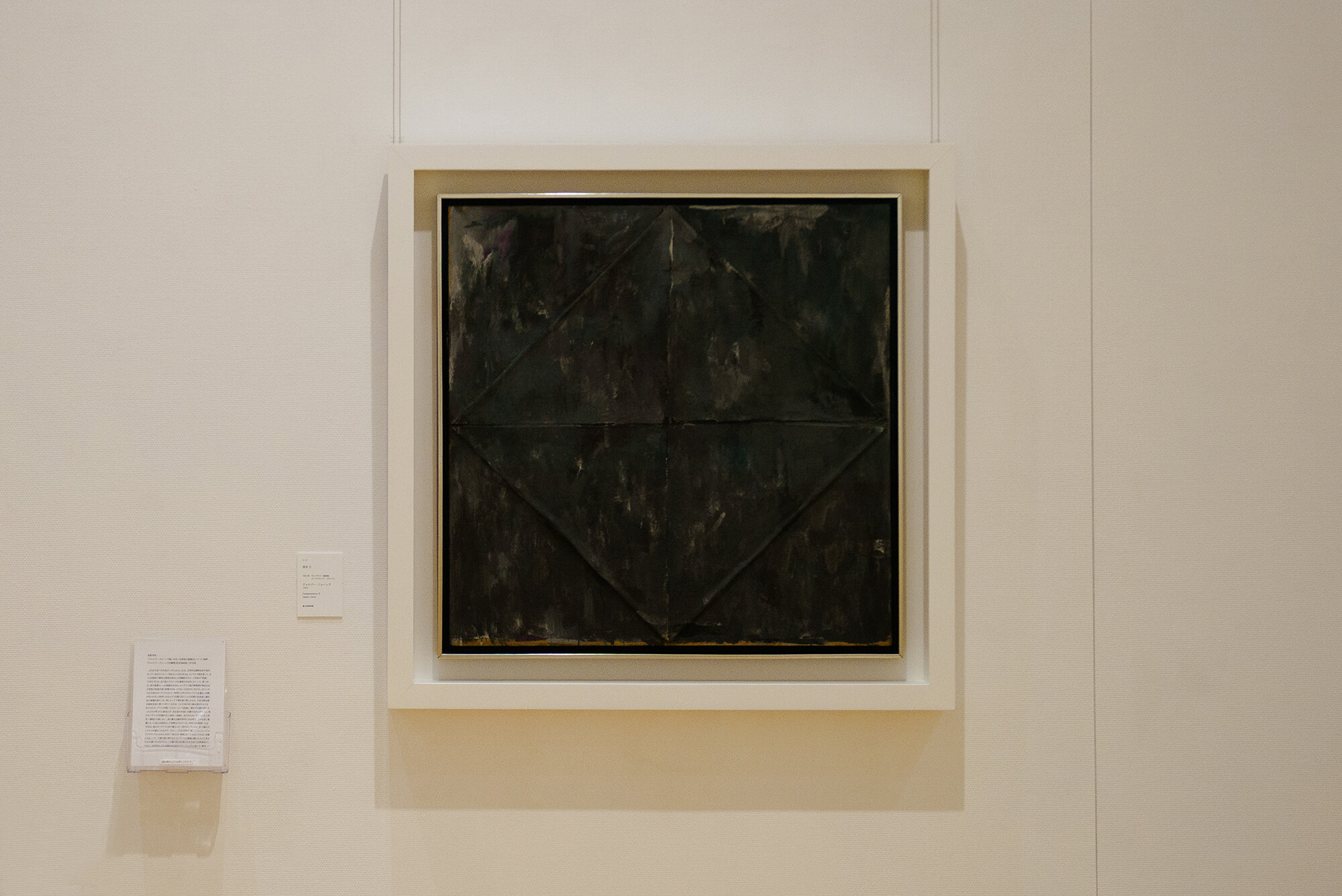
Jasper Johns, Disappearance II, 1961 © Jasper Johns / VAGA at ARS, NY / JASPER, Tokyo 2025 E6026
In this series, museum personnel from around Japan shine a spotlight on a favorite piece from their own museum's collection, works that they hope everyone will see and appreciate. In this fifth installment, we visited the Toyama Prefectural Museum of Art and Design (TAD), which opened in 2017. This museum, formerly the Museum of Modern Art, Toyama, has assembled a collection that is a survey of twentieth century art. Associate Curator Naito Masane chose this work, which was created in America in 1961 and has been in the collection since the museum’s previous incarnation, as his favorite piece.
Pop art within twentieth century art
- Associate Curator Naito Masane’s thoughts about his favorite piece
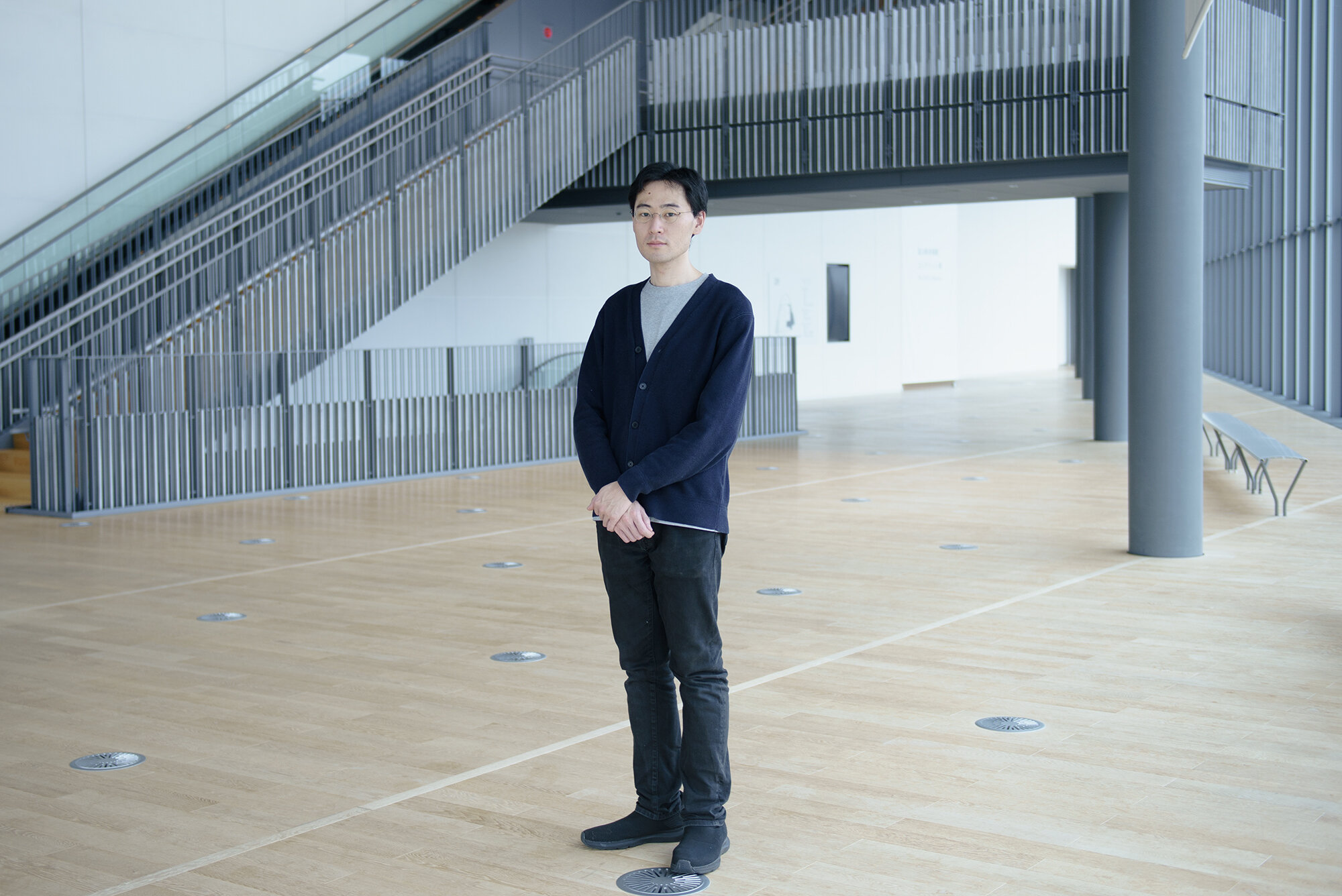
Associate Curator Naito Masane stands in the foyer of the second floor of the Toyama Prefectural Museum of Art and Design
Comprehensive collection of twentieth century art
The building that housed the Museum of Modern Art, Toyama had become tired after thirty-five years, so the museum was relocated to a new building erected in Fugan Canal Kansui Park, reopening in 2017. This well-loved park has been developed at a Fugan Canal boat landing to the north of Toyama Station. The work that Naito chose as his favorite piece is Disappearance II, by Jasper Johns (1930–), one of the most important artists of twentieth century American pop art. It was acquired by the Museum of Modern Art, Toyama in 1980, the year before the museum opened. We asked Naito to tell us the history of how this work came to be acquired by the Museum of Modern Art, Toyama.
“When the Museum of Modern Art, Toyama was being established, it was decided that the museum would aim to assemble a collection that would be a survey of twentieth century art. In advance of the opening, the museum asked art critic Takiguchi Shuzo for his advice on the direction that the museum should take. Takiguchi introduced the museum to art critic Tono Yoshiaki (who looked up to Takiguchi as a spiritual father) and poet and critic Ooka Makoto as advisors on museum management and exhibition planning. Tono contributed to the catalogue that used images and text to introduce the works in the museum's collection at the time of its opening. He wrote that the museum's collection was characterized by the inclusion of works by artists who painted Western-style paintings in Japan before the war. From this we can see that the museum was consciously collecting, researching, and exhibiting works without being biased towards any particular era or genre in order to trace the lineage of twentieth century art.”
The collection, which had been assembled with a cutting-edge attitude beginning even before the museum opened, included many works by as-yet unappreciated contemporary artists. In the past few years there has been renewed interest in the collection of the predecessor museum, which includes works now recognized for their importance in art history. Tono Yoshiaki praised Jasper Johns’ Disappearance II as a touchstone of contemporary art that showed other artists the way. We can surmise that he thought that the work was important as an indicator of the museum’s collection policy and also as a piece that could be exhibited and studied after the museum opened.
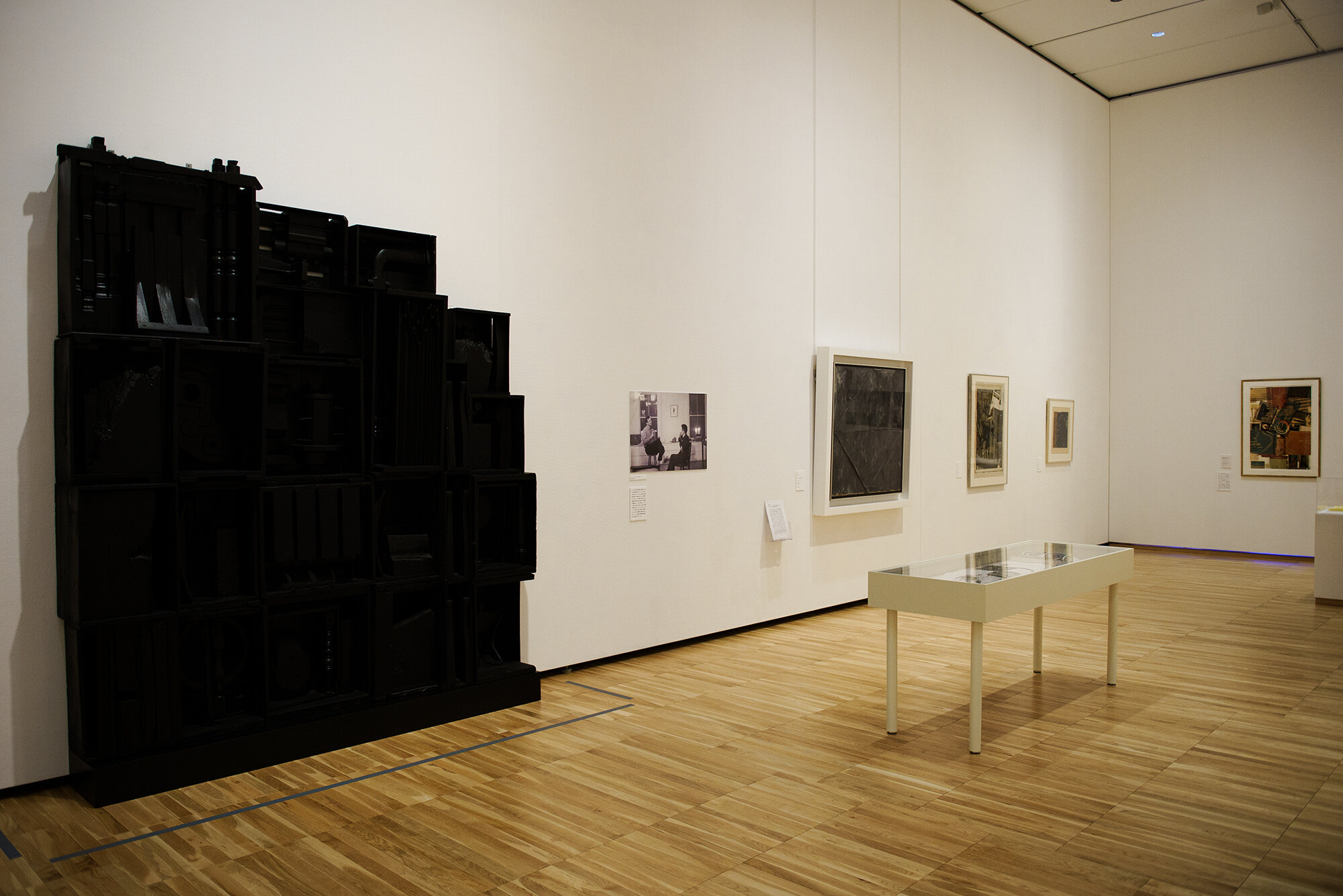
Installation view of Tono Yoshiaki and Postwar Art, a special exhibition on display at the Toyama Prefectural Museum of Art and Design from January 25 to April 6, 2025 that mainly revolved around the permanent collection. The work that is slightly to the right side of the center of the image is Naito’s “favorite piece.”
What is a painting?
From the late 1940s through the 1950s, abstract expressionism gained worldwide acclaim and entered the mainstream of the art world. Then, looking further ahead, in 1962 the Sidney Janis Gallery in New York mounted International Exhibition of the New Realists, which brought together artists seeking new forms of expression. This has been called a key starting point for pop art in America. Naito talked to us about Disappearance II, which was painted in the preceding year.
“Jasper Johns is generally known as a creator of pop art, but Disappearance II is a work from a period that can be considered an embryonic stage. At the time, abstract expressionism was the mainstream, and many artists sought new forms of expression as a counter-reaction to that. I think that Jasper Johns created this work in pursuit of a method of expression that had never existed before, asking himself how a painting should be composed and what materials should be combined to create a painting, sometimes even deconstructing the painting itself.”
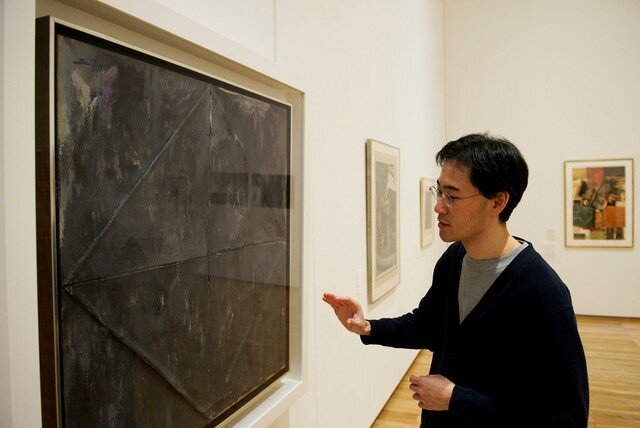
"When you get closer, you can see that there is still some white in the background and that he used a slightly reddish color, so it is not entirely black," says Naito, discussing the details of the painting.
Generally, when we hear the word “painting,” we imagine a single canvas, piece of paper, or board upon whose surface colors have been placed in order to depict some kind of image. However, in Disappearance II Jasper Johns has folded a canvas and pasted it to the base canvas, before painting on the folded surface, presenting this as a completed piece.
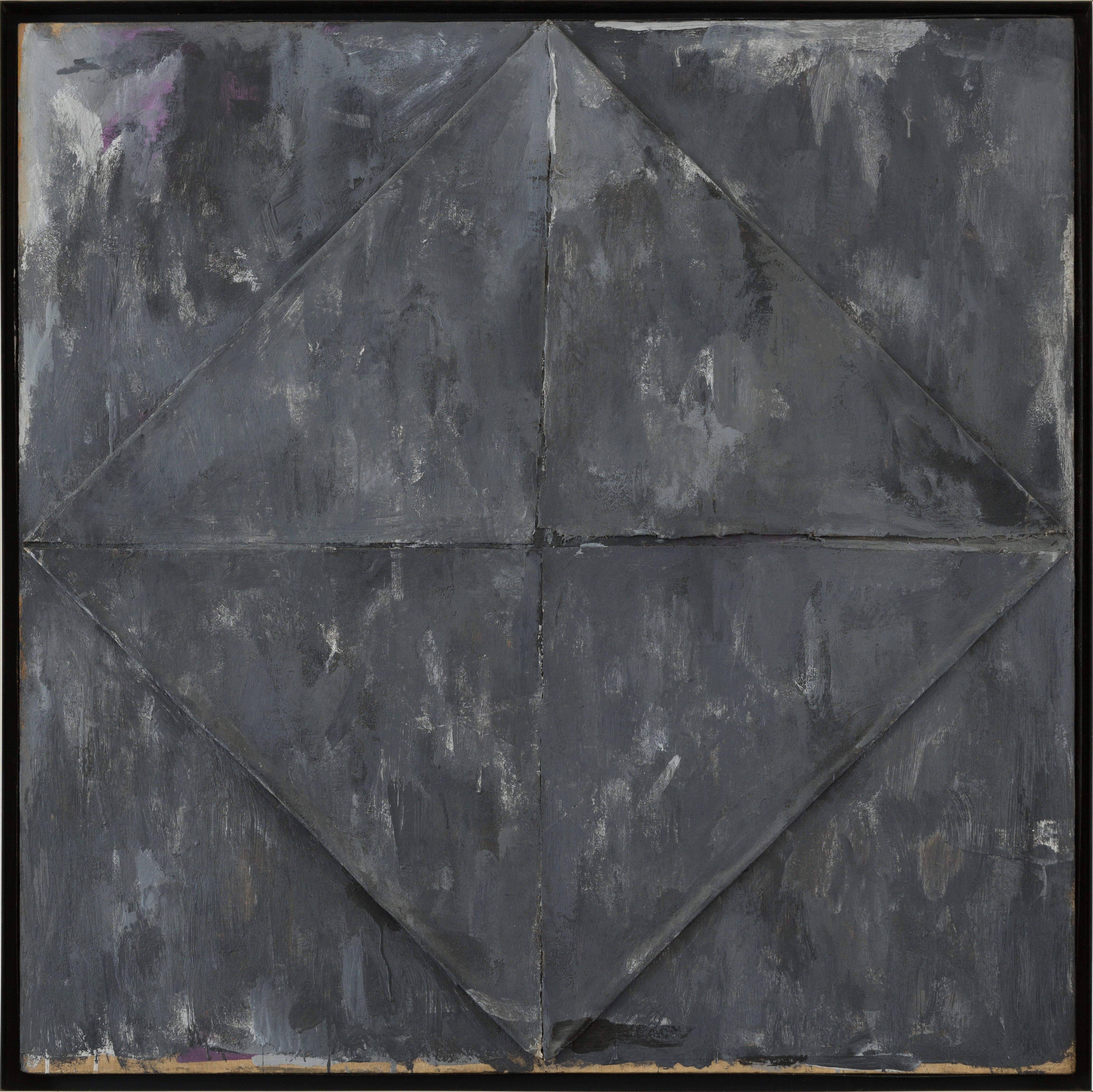
Jasper Johns, Disappearance II (1961), Toyama Prefectural Museum of Art and Design
© Jasper Johns / VAGA at ARS, NY / JASPER, Tokyo 2025 E6026
“The originality of Disappearance II lies in the fact that the story that plays out on the canvas is not told solely through oil paints; canvas—which ordinarily serves as the base of painting—has been added to the surface to become a component of the painting. Using a theatre stage set as an analogy, in his critique of the piece, Tono said that the canvas, which is ordinarily just the stage, caused a structural transformation, and as a result of this it became not merely the stage, but also an actor. He observed that by combining elements in a new way, the piece offered a new idea of what a painting could be.”
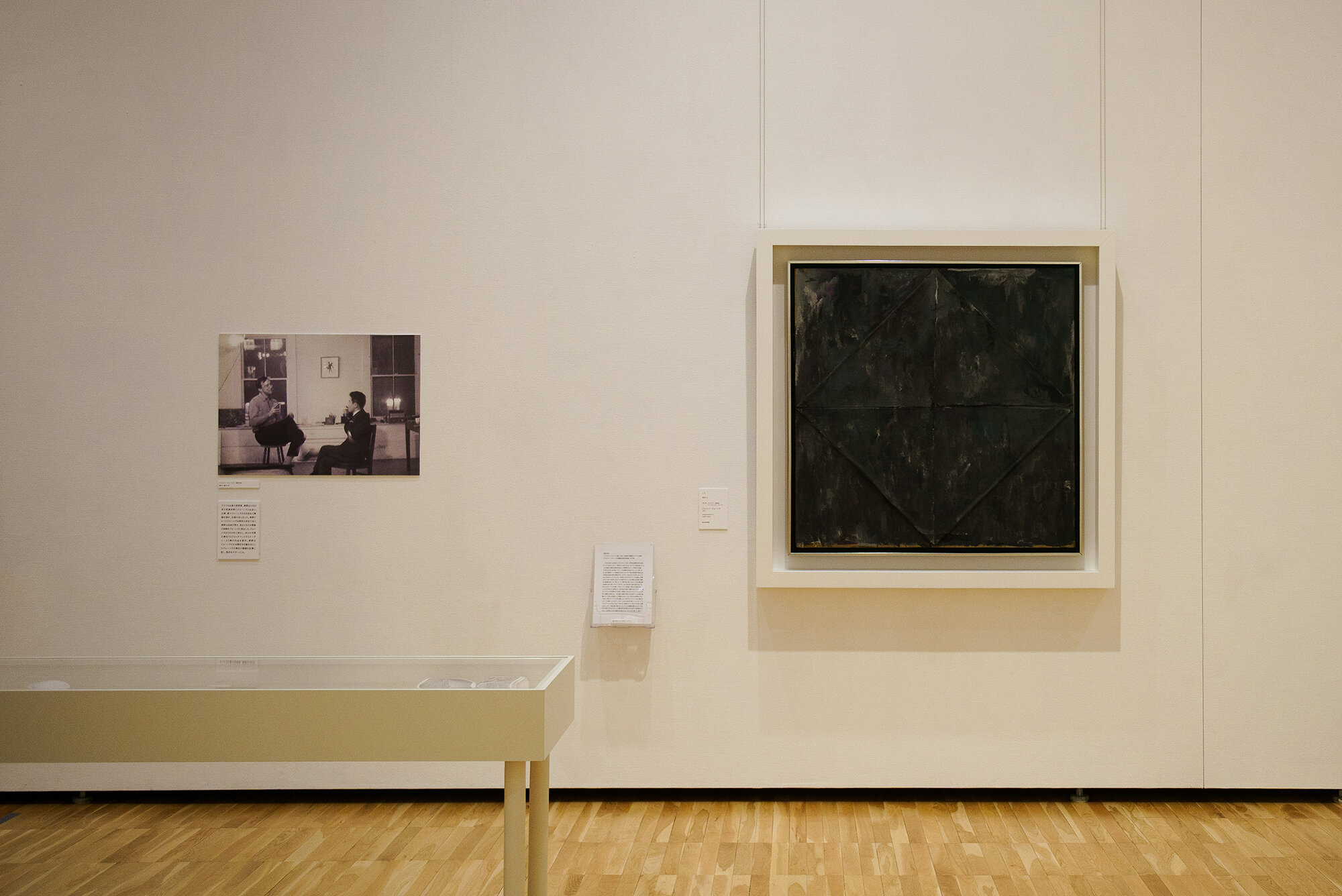
Installation view of the special exhibition, Tono Yoshiaki and Postwar Art (January 25 to April 6, 2025). A snapshot taken of Tono with Jasper Johns hangs beside Disappearance II.
Naito studied Sunazawa Bikky during his student days
Associate Curator Naito Masane, who joined TAD after completing his graduate studies at art school, studied Sunazawa Bikky (1931–1989), a sculptor with Ainu roots, while at university.
“There is a piece by Sunazawa that was installed outdoors in Sapporo, and now that roughly thirty years have passed, parts of it have rotted and collapsed. It is weathering and returning to the earth. It has been some years since the artist died, but during his lifetime he left behind some poetic words saying that this kind of weathering is part of nature's creative work. So how should we interpret his words? How should we see the relationship between a museum and an artist, or the artworks themselves? I wanted to think about art—including these questions—so I decided to study Sunazawa Bikky.”
How should we interpret an artist's expression, including their words? What kind of relationship can a museum build with artists? Naito says that by studying just one artist, he came to think about art not just in terms of the works themselves, but also their surroundings.
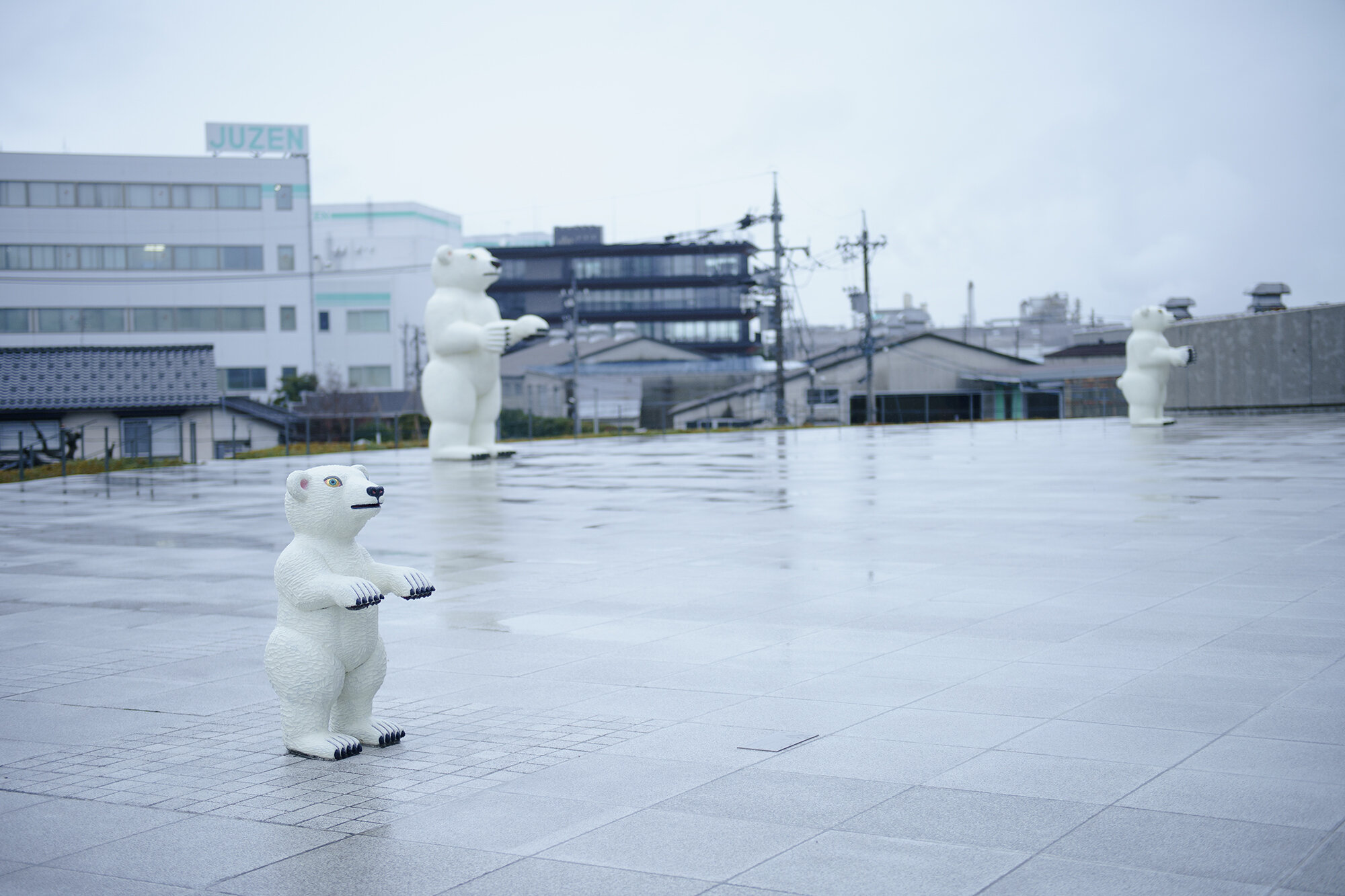
Three pieces from Misawa Atsuhiko's Animal 2017 series are installed on the second floor outdoor plaza of the Toyama Prefectural Museum of Art and Design. These works were commissioned by the museum after many discussions with the artist about where and what sorts of pieces would be installed at the museum for its opening in 2017. These works symbolize how TAD values its relationships with artists. From right to left: Animal 2017-02-B, Animal 2017-01-B, Animal 2017-03-B.
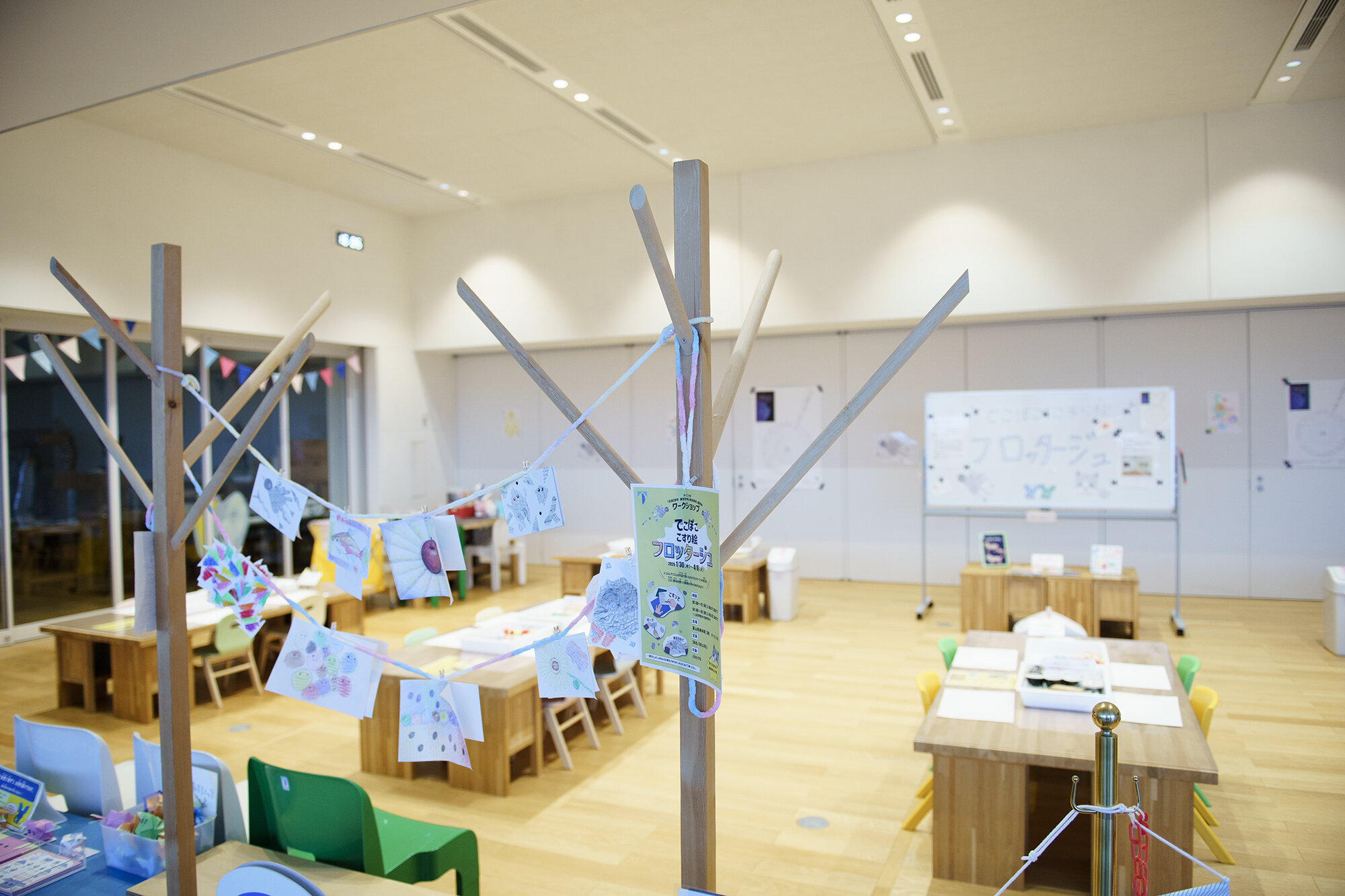
The atelier, which holds workshops covering everyone from small children to adults, is located on the third floor. “By not just viewing works of art but also making them for themselves, people can create shapes that they have thought up themselves, and this should allow them to understand art in a three-dimensional way and enjoy art even more,” says Naito, who intends to focus on planning atelier events in conjunction with exhibitions.
Pop art within twentieth century art
This favorite piece, Jasper Johns’ Disappearance II, is connected to the concept behind one of the collection exhibitions to be on display from July 17 to October 28, 2025. The title of this exhibition is Before and After Pop: TAD Museum Collection +. This project was selected to be part of the Collection PLUS public initiative in which the National Center for Arts Research (NCAR) collaborates with art museums across the country to activate the collections of Japan's national art museums. Alongside TAD’s extensive collection of American art from the mid-twentieth century onward, the exhibition is also slated to display works from the National Museum of Art, Osaka. These are Queen of the Night I (1951), by Barnett Newman, who was one of the foremost artists in the abstract painting genre known as color field painting, and 10 Day Wait At Mugda (1963) by Cy Twombly, who is known for his poetic works that combine abstract painting and calligraphy. As part of the Collection PLUS initiative, the museum will also present Picasso: Portraits and Model, an exhibition that brings together works from the collections of the National Museum of Art, Osaka and the Toyama Prefectural Museum of Art and Design.
“As they searched for their own methods of expression, pop art creators naturally studied painting by looking at works from earlier genres, including abstract expressionism. Where does pop art stand within the history of art in the twentieth century? The counter-reaction to abstract expressionism, which was the mainstream, is seen as the catalyst for the emergence of pop art. To look at the art in this context, we are borrowing these works by Barnett Newman and Cy Twombly, which are not in our collection, to give visitors a view of twentieth century art with more substance.”
Ordinarily, only one room is used for the museum’s collection exhibitions, but this has been expanded to two rooms while Collection PLUS is being shown. One room will be used for the regular collection exhibition, and another room will be used to show Before and After Pop: TAD Museum Collection + and Picasso: Portraits and Model. This will be a rare opportunity to learn about the trajectory of twentieth century art through the two museums’ extensive collections.
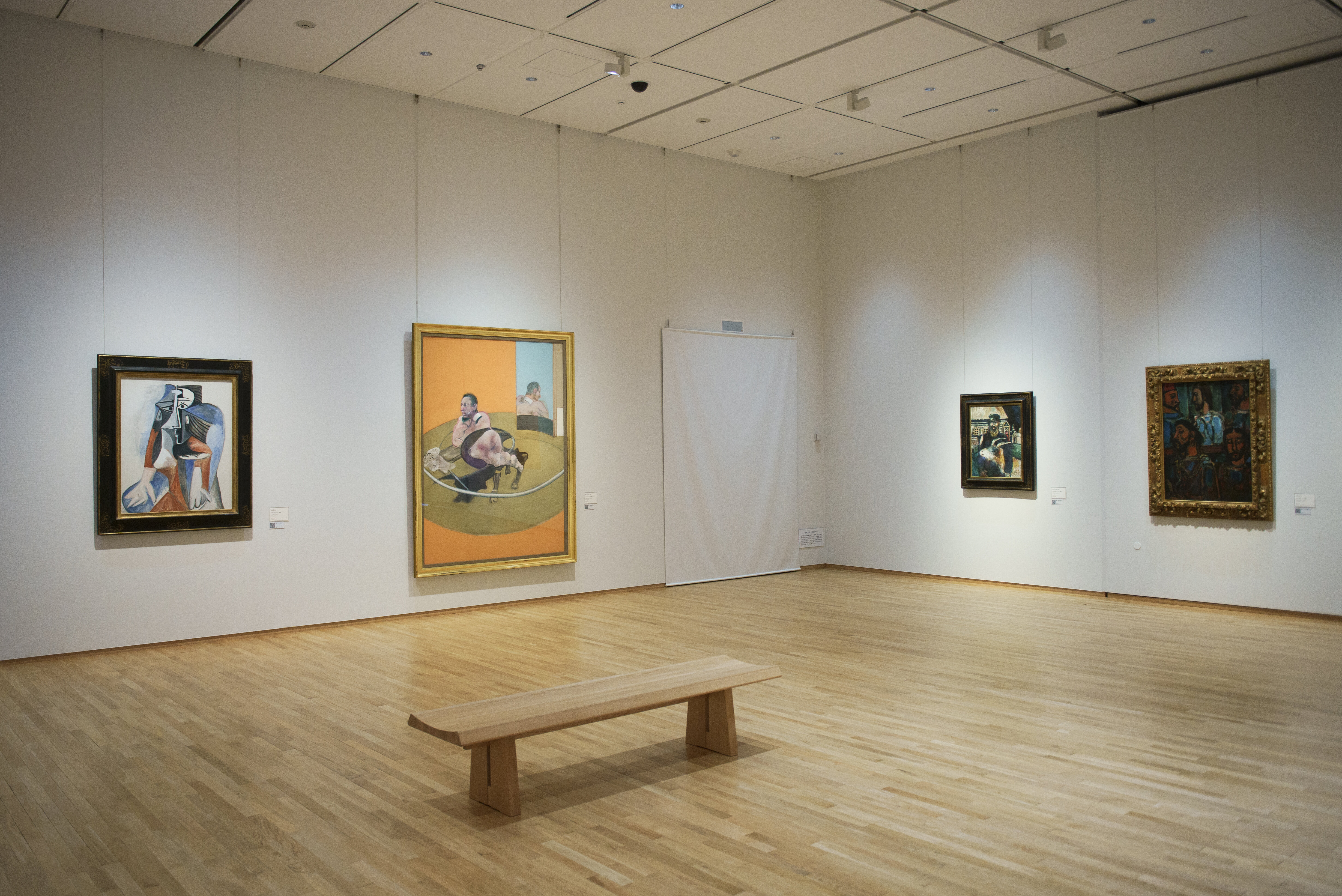
Installation view of TAD Collection IV (February 6 to April 22, 2025), which was being shown during the author’s visit.
Associate Curator Naito Masane’s thoughts about his favorite piece
Naito explained why he selected Jasper Johns’ Disappearance II as his favorite piece.
“When I selected this work, I was thinking about how I chose pop art’s position within twentieth century art as the theme when I was planning Collection PLUS. This is a piece that gives us a glimpse into the types of works that were created from the era of abstract expressionism to the embryonic stage of pop art.”
He then offered some thoughts about this favorite piece.
“It has been noted that Jasper Johns was going through a period of disappointment in his personal life at the time that he created this work. The work is painted entirely in black, and from the title, Disappearance II, it can be inferred that the artist felt a hole in his heart and a sense of emptiness and loss. However, if we closely examine the work, we can see that there is still some white remaining in the background, and purplish hues were used, so we can imagine that he might have held the faint hope that he would overcome his disappointment. Along with using a new technique in which canvas becomes a component of the painting—a technique that emerged from the counter-reaction to traditional painting—this piece also incorporates colors that can only be seen when one is standing directly in front of the painting. I feel that it is a work that strongly stimulates the imagination when viewed in person, and it has made me wonder how the artist's ambition to find new forms of expression was related to his psychological state at the time he created the work. This is why I chose it.”
At Toyama Prefectural Museum of Art and Design, the themes for our collection exhibitions change regularly, so this “favorite piece” is not always on public display. Please contact the Toyama Prefectural Museum of Art and Design for information about when it will be on display.
Naito Masane
Born in Hokkaido, Naito has been working as an associate curator at the Toyama Prefectural Museum of Art and Design since 2021. He has been involved in the special exhibitions The World of Illustrations for Children's Books 2022, with works from the Miyagi Museum of Art; DESIGN SCOPE; Shinro Ohtake; and MINGEI: The Beauty of Everyday Things.
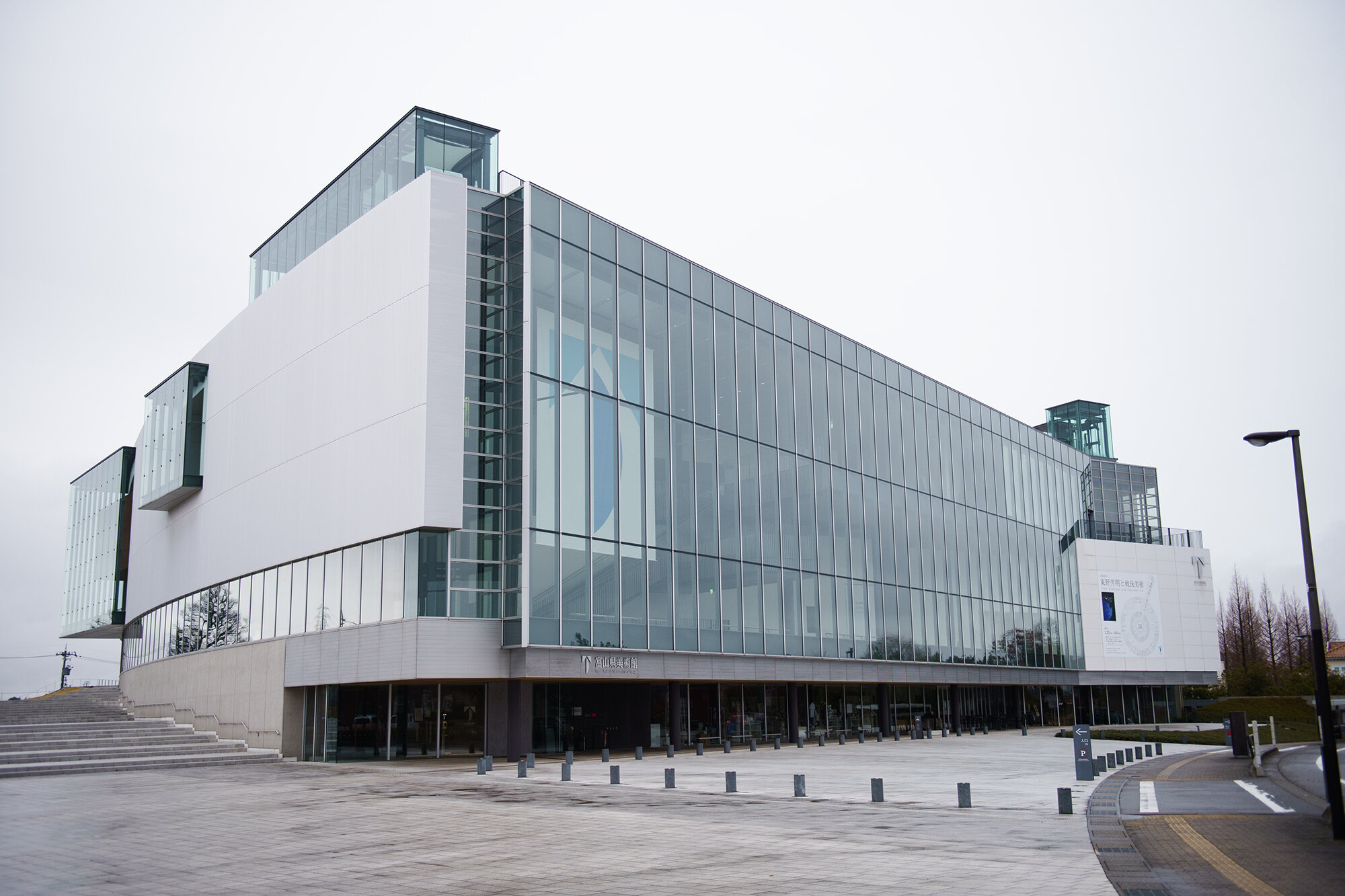
Toyama Prefectural Museum of Art and Design
Interview and photographs by Nakajima Ryohei







